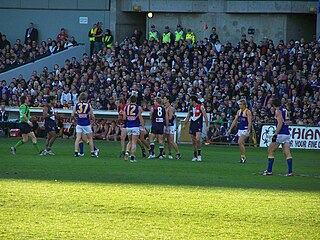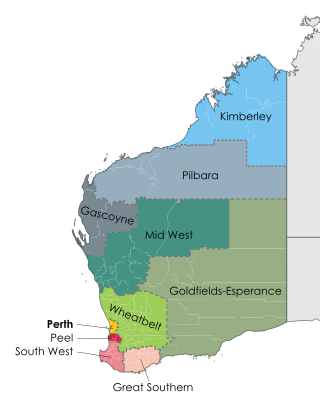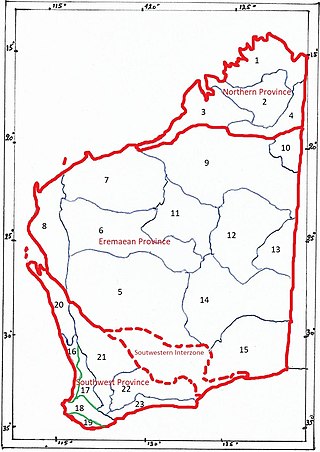
Western Australia is a state of Australia occupying the western 33 percent of the land area of Australia, excluding external territories. It is bounded by the Indian Ocean to the north and west, the Southern Ocean to the south, the Northern Territory to the north-east, and South Australia to the south-east. Western Australia is Australia's largest state, with a total land area of 2,527,013 square kilometres (975,685 sq mi). It is the second-largest country subdivision in the world, surpassed only by Russia's Sakha Republic. As of 2021, the state has 2.76 million inhabitants—11 percent of the national total. The vast majority live in the south-west corner; 79 percent of the population lives in the Perth area, leaving the remainder of the state sparsely populated.

The Great Sandy Desert is an interim Australian bioregion, located in the northeast of Western Australia straddling the Pilbara and southern Kimberley regions and extending east into the Northern Territory. It is the second largest desert in Australia after the Great Victoria Desert and encompasses an area of 284,993 square kilometres (110,036 sq mi). The Gibson Desert lies to the south and the Tanami Desert lies to the east of the Great Sandy Desert.
The Pilbara is a large, dry, thinly populated region in the north of Western Australia. It is known for its Aboriginal peoples; its ancient landscapes; the red earth; and its vast mineral deposits, in particular iron ore. It is also a global biodiversity hotspot for subterranean fauna.

The Wheatbelt is one of nine regions of Western Australia defined as administrative areas for the state's regional development, and a vernacular term for the area converted to agriculture during colonisation. It partially surrounds the Perth metropolitan area, extending north from Perth to the Mid West region, and east to the Goldfields–Esperance region. It is bordered to the south by the South West and Great Southern regions, and to the west by the Indian Ocean, the Perth metropolitan area, and the Peel region. Altogether, it has an area of 154,862 square kilometres (59,793 sq mi).
Horizon Power is a commercially focused, state government-owned, power company that provides power supplies to Western Australia. It is responsible for generating, procuring, distributing and retailing electricity to residential, industrial and commercial customers and resource developments in its service area.

Australian rules football in Western Australia (WA) is the most popular sport in the state and Western Australia has the second highest number of Australian rules football participants of any state.

Pilbara newspapers is a selection of newspapers published in the Pilbara region of Western Australia.

The North West, North West Coast, North Western Australia and North West Australia, are usually informal names for the northern regions of the State of Western Australia. However, some conceptions of "North West Australia" have included adjoining parts of the Northern Territory (NT) – or even the entire NT.
Western Australia has the longest coastline of any state or territory in Australia, at 10,194 km or 12,889 km. It is a significant portion of the coastline of Australia, which is 35,877 km.
The south coast of Western Australia comprises the Western Australian coastline from Cape Leeuwin to Eucla. This is a distance of approximately 1,600 kilometres (1,000 mi), fronting the Great Australian Bight and the Southern Ocean.

The Regional Development Commissions Act 1993 is legislation passed by the Parliament of Western Australia:
to establish regional development commissions, to coordinate and promote the development of regions and to establish a regional development council.
The 1900 Western Australian floods were a series of flooding events from March to May 1900 that affected large areas of Western Australia, primarily in the Pilbara and Gascoyne regions, though it extended to cover most of the state except the more humid Kimberley and South West regions.

The Australian Country Football League (WACFL) is the governing body for the sport of Australian rules football in the non-metropolitan areas of Western Australia. The organisation was founded in 1973 as the Western Australian National Country Football League (WANCFL), its name to the current in 1979. The WACFL is also responsible for organising the Landmark Country Football Championships, contested between the various regional sides. The Australian Country Football Championships were hosted by Bunbury in 2004.
The Eremaean province is a botanical region in Western Australia, characterised by a desert climate. It is sometimes referred to as the dry and arid inland or interior region of Western Australia It is one of John Stanley Beard's phytogeographic regions of WA, based on climate and types of vegetation who, in "Plant Life of Western Australia" (p. 29-37) gives a short history of the various mappings.
Newspapers published or distributed in the Gascoyne region of Western Australia have been spread over a large distance, and in varying degrees of success. The region has a low population density, and some communities, apart from Carnarvon, would not be sufficient to support long term newspaper production.
A modest number of newspapers have been produced in, or for, the Kimberley region of Western Australia. Few are still being published today. Some of the newspapers reflect the economic interests of the region, but not to the same extent that is seen in Pilbara newspapers. There is some cross-over between newspapers distributed in both the Kimberley and the Pilbara.

The botanical provinces of Western Australia (or Beard's Provinces) delineate "natural" phytogeographic regions of WA, based on climate and types of vegetation. John Stanley Beard, in "Plant Life of Western Australia" (p. 29-37) gives a short history of the various mappings.



















